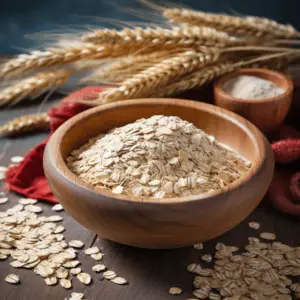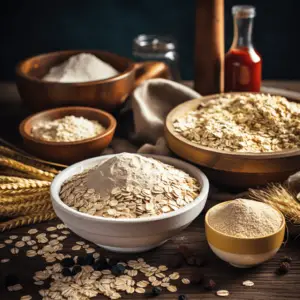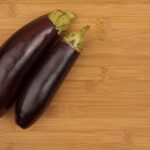Oat Consumption, Quaker oats are technically not raw but yes you can eat them without cooking them any further.
Quaker oats are a popular whole grain breakfast cereal. Quaker oats are prepared from raw oats. Unprocessed oats are safe to eat uncooked, but they have minimal nutritional value.
The oat kernels are indigestible to humans and many animals.
Unprocessed raw oats feed the body with insoluble fiber that is wasted.
Large volumes of these undigested kernels will induce indigestion, stomach irritation, and severe blockage and constipation since they cannot be broken down.
Quaker oats are processed:
- Removal of the kernels and husks to separate them from the grain
- Milling to shape or cut them to certain shapes and sizes
- Moisture treatment
- Heat treatment
- Categorization
The end product of the above process is an oat that is digestible and safe to eat straight from the packaging which is what most people call raw but is actually cooked.
Unlike raw oats, Quaker oats or processed oats are safe to eat dry, soaked, cooked, or blended. The milling process and the treatments thereof make the oats digestible in the human digestive tract and the nutrients they contain thus become bioavailable.
Table of Contents
Can you eat Quaker oats raw? Here are Different Types of Quacker Oats

Dry Quaker Oats
Quaker oats can absolutely be consumed this way but they are hardly palatable and do not taste as good on their own.
Additionally, the dry oat is quite filling and since it is a whole grain it is still very high in fiber which can be very dehydrating to the body.
The high fiber content still needs to be broken down further for it to benefit the body.
Quaker oats, while digestible in dry form may still wind up not releasing their nutrients, especially when consumed in large amounts on a consistent basis.
Although the fiber provided by the processed grain is now soluble it still takes a long time for the body to break it down and even more to break it down enough to absorb as many of the nutrients as there are in Quaker oats.
This means that they can also cause constipation and indigestion if consumed in large amounts.
Quaker oats should be eaten dry in small amounts or infrequently for optimal benefit.
Soaked Quaker Oats
A better way to consume quaker oats would be to soak them in low-fat milk, non-dairy milk such as almond milk juice, or just plain water.
Soaked oats tend to taste much better than dry oats and the effect of soaking means that the grain becomes even softer and easier to break down.
The added fluids also mitigate dehydration which is a common effect of eating oats and a known precursor for stomach upsets, indigestion, and constipation which can be caused by fiber-dense and nutrient-dense oats.
Blended Quaker Oats
Quaker oats can be included in a smoothie which is both a sumptuous and a healthy way to eat quaker oats.
The pulverized oats are almost completely broken down and all that is left for the body to do is some minor work to extract the nutrients contained in oats.
The easier digestion serves to facilitate maximum access and absorption of nearly all or most of the nutrients available in oats.
Cooked Quaker Oats
Oat Consumption is the recommended way to enjoy oats.
The heat dissolves and weakens many chemical bonds which is what the digestive system attempts to do in order to extract specific nutrients and substances.
By cooking oats, you will effectively be predigesting the oats so to speak.
Just like most vegetables, nutrient-dense foods tend to have nutrients that the body cannot digest and extract easily unless the food stays in the digestive tract for much longer than the few hours that the digestion process takes.
Consuming nutrient-dense foods such as whole grains can therefore end up being counterproductive Oat Consumption their nutritional value is not available to be extracted within the digestion timeline. This means that all those nutrients send up wasted anyway.
One of the most effective ways to prevent this is to cook such foods and oats fall squarely in that category.
Oat porridge is easy to make, very filling, highly nutritious, delicious, and does not dehydrate the body. Since it ticks all the boxes, oat porridge is one of the best breakfast items.
How to make Quaker oat porridge
- Pour milk into a saucepan and allow it to gather some heat.
- Processed milk does not need to boil at this stage.
- Pour a healthy single serving of Quaker oats into the milk and stir.
- Make just enough to consume at once since keeping the porridge will render it too soggy and unpalatable.
- If you wish you may add a small amount of sugar at this stage.
- Stir continuously over a small flame.
- Let the mixture simmer lightly to make a thick sludge.
- Turn off the flame and let it cool to your liking.
- At this point, you can add some honey or stevia if you had not used sugar.
- Pour into a bowl then drop some strawberries or raisins into the porridge, and enjoy.
The nutritional profile of oats

Oats contain the following nutrients in varying quantities:
- Carbohydrate
- Fiber
- Fat
- Protein
- Iron
- Zinc
- Folate
- Copper
- Phosphorous
- Manganese
- Magnesium
- Calcium
- Potassium
- Vitamin B1
- Vitamin B3
- Vitamin B5
- Vitamin B6
Most of these are available in small quantities and are difficult to extract which is why cooking oats is highly recommended.
Despite the rich nutritional profile of oats, they should be eaten as part of a varied balanced diet and not as a singular dietary item.
Oat Consumption moderate quantities, oats offer a world of benefits including the coveted weight loss and weight management quality which has seen the consumption of oats skyrocket in the last decade.


